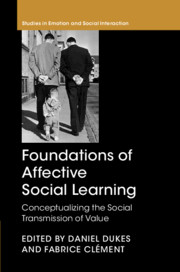Book contents
- Foundations of Affective Social Learning
- Studies in Emotion and Social Interaction
- Foundations of Affective Social Learning
- Copyright page
- Dedication
- Contents
- Figures
- Contributors
- Preface
- A difficult introduction to affective social learning
- Part I On the evolutionary foundations of affective social learning processes
- Part II On human development and affective social learning
- Part III On the mechanics of affective social learning
- Chapter 5 Calibrating emotional orientations
- Chapter 6 Socio-affective inferential mechanisms involved in emotion recognition
- Chapter 7 Learning from others’ emotions
- Part IV Applications of affective social learning
- Conclusion
- Index
- Studies in Emotion and Social Interation
- References
Chapter 6 - Socio-affective inferential mechanisms involved in emotion recognition
from Part III - On the mechanics of affective social learning
Published online by Cambridge University Press: 09 August 2019
- Foundations of Affective Social Learning
- Studies in Emotion and Social Interaction
- Foundations of Affective Social Learning
- Copyright page
- Dedication
- Contents
- Figures
- Contributors
- Preface
- A difficult introduction to affective social learning
- Part I On the evolutionary foundations of affective social learning processes
- Part II On human development and affective social learning
- Part III On the mechanics of affective social learning
- Chapter 5 Calibrating emotional orientations
- Chapter 6 Socio-affective inferential mechanisms involved in emotion recognition
- Chapter 7 Learning from others’ emotions
- Part IV Applications of affective social learning
- Conclusion
- Index
- Studies in Emotion and Social Interation
- References
Summary
Among social stimuli, the human face is unique. Its properties and features, both static and dynamic, reveal different aspects of a person. Perceivers use this information when they aim, for example, to recognize individuals, identify their social groups, discern their personality, detect their focus of attention, understand their verbal and non-verbal behaviours, and infer their emotions. Emotions that we read from facial actions are crucial to social interaction: They provide information that helps us understand social intentions, how to react to others, and to evaluate the affective meaning of many events that we encounter in our environment. In this chapter, we focus on social appraisal – one of the central mechanisms involved in affective social learning. In particular, we discuss the notion that, through a particular socio-affective inferential mechanism, social appraisal plays a significant role when the emotional expression of person A is used to learn about the value of the emotion expressed by person B. The first section of this chapter provides a brief historical introduction to the relation between contextual information and emotion recognition in faces. Then, we focus on the construct of social appraisal and its manifestation in socio-affective inferential mechanisms involved in emotion recognition. In the third section, we present empirical evidence supporting the automaticity of such socio-affective inferential mechanisms and discuss its implication for the theoretical framework of affective social learning. Next, we discuss the idea that ambiguous situations may be particularly prone to social appraisal taking place. Finally, we discuss how social appraisal, underpinned by a socio-affective inferential mechanism, may be integrated into the affective social learning framework.
Keywords
- Type
- Chapter
- Information
- Foundations of Affective Social LearningConceptualizing the Social Transmission of Value, pp. 142 - 164Publisher: Cambridge University PressPrint publication year: 2019
References
- 2
- Cited by



